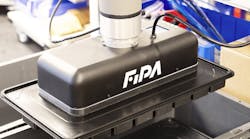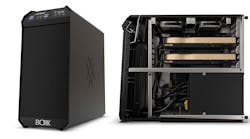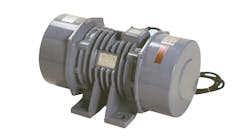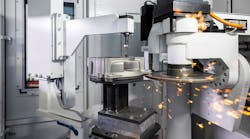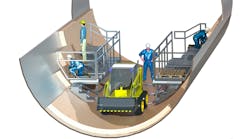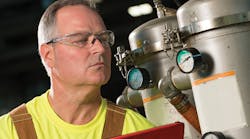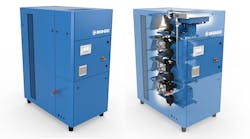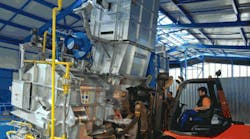STRIKOWESTOFEN reports its new shaft furnace design – PurEfficiency - consumes just 525 kWh of energy when melting and holding 1 metric ton of aluminum, a standard of energy efficiency previously achieved only by using regenerative combustion systems. Developed as part of an R&D project promoted by the German Federal Ministry of Economics (BMWi), the first unit was installed in May of this year at Kovolit a.s., in Modrice, Czech Republic.
Furnaces in the PurEfficiency series are available in a fixed or tilt-able styles, in the following capacities: 3,000-kg bath capacity /1,500-kg per hour melting capacity; 4,000-kg bath / 2,500-kg per hour melting; and 6,000-kg bath / 3,500-kg per hour melting.
Kovolit’s MH II (PE)-T 3000/1500 two-chamber melting and holding furnace has a holding capacity of 3,000 kg and an hourly melting capacity of 1500 kg. In trials under actual foundry conditions, an energy consumption of 525 kWh/t was achieved for the first time, including melting consumption and reheating capacity for a constant bath temperature of 720°C. Pig iron was charged at 6 kg as well as the foundry’s aluminum returns.
The increase in energy consumption is minimal during everyday operation, when holding operations regularly interrupt melting. For the month of July, Kovolit reported an average gas consumption of 560 kWh/t for melting, with a bath temperature of 730°C. “The level of energy-efficiency of the furnace hereby lies in the same efficiency class as furnaces with regenerative combustion systems, and well above the previously achieved values for comparable aluminum melting furnaces with cold air burners,” StrikoWestofen stated.
In addition, the PurEfficiency series furnace design is only slightly larger than the comparable StrikoMelter furnace. Specifically, the height of the shaft melting furnace is unchanged. “The new furnace technology, its operation and reliability, prompt delivery without any start-up difficulties in spite of the fact that it is new technology, and last but not least, the low gas consumption, has exceeded our expectations,” according to Eduard Marecek, managing director of Kovolit.
The developer’s StrikoMelter shaft furnaces use waste heat from the melting process to preheat the furnace charge in the shaft. The integrated heat recovery system ensures a high level of energy-efficiency; the rapid melting process minimizes metal oxidization. The shaft geometry makes it possible to achieve energy consumption levels below 600 kWh when melting and heating one metric ton of aluminum at 720°C. At average melting capacity this leads to annual cost savings of up to €40,000 (est. $30,000), compared to modern melting furnaces without the ETAMAX shaft. With the PurEfficiency series, according to StrikoWestofen, this saving increases to €50,000 (est. $37,000).
This increase in the efficiency level was achieved with the help of CFD numerical simulation procedures. Various furnace chamber geometries, burner layouts and insulation strengths were analyzed and compared, so that the flow system, heat transfer and temperature distribution can be optimized.
The objective of the BMWi development project was to reduce energy consumption by 10-15% compared to the StrikoMelter with ETAmax waste-heat utilization function, without increasing the height of the furnace. A shaft extension has successfully increased efficiency for numerous foundries, but this solution requires sufficient ceiling height that is not always available.
The targeted increase in efficiency was achieved by a thorough consideration of the furnace body, the fire-resistant lining, and the burner design. The result is an optimized design of the burners, the shape of the combustion chamber, and the melting chamber volumes, as well as high-capacity utilization of the shaft space. Control of the burner performance is customized to the user’s requirements. Laser technology ensures a continually high shaft fill level, making maximum advantage of the shaft cross-section.
The developer emphasized that the design’s potential for sustainability conservation of resources is evident when the entire lifecycle of a furnace is considered, noting that energy costs, metal loss, and furnace maintenance constitute more than 95% of the total costs throughout the operating life of a melting furnace. As such, the PurEfficiency’s furnace lining was reviewed and improved in areas that endure a high level of mechanical stress. Working with refractory suppliers, new castable compounds were used in the shaft area and areas under mechanical stress were stabilized. This reduced wear of the fire-resistant lining and extended service life.
In terms of furnace insulation, new materials with improved insulating qualities are used. StrikoWestofen uses calcium silicate plates around the entire circumference. An insulating layer with a uniform wall structure is applied throughout, except in the burner area, so that offset points and heat bridges are reduced to a minimum. In order to completely seal the doors, sealing cords are used, which fit neatly into a groove in the furnace door. Thus, foundries will achieve operating cost savings and the furnace will have a long lifespan with low repair costs.
